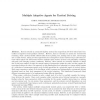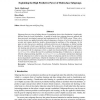529 search results - page 101 / 106 » Population Training Heuristics |
BMCBI
2005
13 years 6 months ago
2005
Background: The SH3 domain family is one of the most representative and widely studied cases of so-called Peptide Recognition Modules (PRM). The polyproline II motif PxxP that gen...
AIR
1998
13 years 6 months ago
1998
Plankton form the base of the food chain in the ocean and are fundamental to marine ecosystem dynamics. The rapid mapping of plankton abundance together with taxonomic and size com...
APIN
1998
13 years 6 months ago
1998
Abstract. Recent research in automated highway systems has ranged from low-level vision-based controllers to high-level route-guidance software. However, there is currently no syst...
PRL
2007
13 years 6 months ago
2007
Performance quantification of biometric systems, such as face tracking and recognition highly depend on the database used for testing the systems. Systems trained and tested on r...
JMLR
2010
13 years 1 months ago
2010
Subgroup discovery aims at finding subsets of a population whose class distribution is significantly different from the overall distribution. A number of multi-class subgroup disc...


